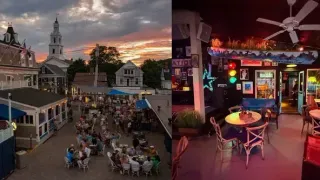January 19, 2022
Annabelle Mauger on Imagining Van Gogh as Immersive Art
Kilian Melloy READ TIME: 9 MIN.
Boston's art lovers are graced with an embarrassment of riches as 2022 gets underway – Vincent Van Gogh riches, that is – with two exhibitions of his work in town concurrently. EDGE had the pleasure of chatting with the creator of one of those two shows.
"Imagine Van Gogh: The Immersive Exhibition" – also known as "Imagine Van Gogh," the title it's showing under through March 19 at SoWa Power Station in Boston – lays claim to having originated the exhibition of Van Gogh's work through high-quality projected images. Created by Annabelle Mauger and Julien Baron, the show projects high-resolution still images of Van Gogh's works, with the images – accompanied by musical selections by Mozart, Bach, Saint-Saëns, and Satie – adjusted for optimal projection onto the surfaces being used. (The show's official site explains this technique in greater technical detail.)
A number of similar exhibitions (including the other Van Gogh show in Boston right now, the similarly-named Van Gogh – The Immersive Experience," at the Strand Theatre) have sprung up since Mauger and Baron created the original immersive Van Gogh exhibition, which premiered in 2008 at Cathédrale d'Images in France.
Mauger explained to EDGE why her take on the immersive art experience avoids animating elements of the images, sharing an anecdote with EDGE about how, in order to understand what it was Van Gogh was seeing when painting "Starry Night" all those years ago, she replicated his experience and "stood almost the entire night, looking for the exact same sky as he was painting, where you see the Big Dipper," a constellation that is visible in the famed work of art.
"You know, that's why it's important not to make the painting move," Mauger goes on to say. "If you read the letter Vincent wrote to Teo, his brother, he is really explaining that he spent days and nights and weeks thinking about the 'Starry Night' – which moments he will choose; the colors, of course, but how it looks. You see a bit of a cypress tree," in the canvas, Mauger explains, "then you can see a bit of the church. That was all so important for him."
The sense of place where the artist was working, and of the artist's vision as he committed it to canvas, is of crucial importance to Mauger. It's something she wants to share with the public through high-resolution images of the original works that she has painstakingly formatted specifically to work in the spaces of SoWa Power Station, as she's also done for all the other venues that have hosted the show.
Mauger tells EDGE that her initial idea for the exhibit was to focus on "the two last years of paintings of Van Gogh, which were the years he painted all those paintings in Provence" – more than 300 works, both drawings and paintings, in a short space of time – "and also in Auvers-sur-Oise, where he finished his life."
"That was for me the most important, because he had many paintings before in Paris," as well as in other locales where he had lived and worked. "But for me, the most important was to see what he painted in Arles; those years were the ones where he really decided to be a painter," Mauger adds. "And that's why I can't make it move. I can make many things move, but not that."
Here's what else Annabelle Mauger had to say about the exhibit, a sensation all during its tour through Canadian cities over the last two years, and which is slated to continue its North American tour in Tacoma/Seattle starting March 5.
EDGE: Your 2008 show is credited with inspiring other exhibits that show images of famous works, rather than the works themselves. I saw an exhibit in Berlin about five years ago called "Von Monet bis Kandinsky" ("From Monet to Kandinski"), and what I found most striking in that show were the works by Van Gogh.
Annabelle Mauger: I haven't seen the one in Berlin. But what I can say to you is, I did this exhibition in 2008. I wanted to show the visitors how Van Gogh was painting the country.
EDGE: What initially gave you the thought that Van Gogh was the painter you'd want to focus on for an exhibit of this type?
Annabelle Mauger: It's almost the same question all the time: Why do we have to put it in an immersive way? It's to see how all those brushstrokes which are so straight, so violent sometimes, and to take a bit of distance with it and see that it's curved, it's soft. That's important. And if you don't have it in an immersive way, you don't see it. And the second thing is that [in an immersive exhibition] you can see the details. Of course, it's not the real painting; you don't have the thing in front of you. It's just a picture. But seeing the details is different; you can see how he was painting. And for me, it's so important.
I just finished another new exhibition about Monet; it's the same thing. You really can see how he's painting, and that's something very new in a way of discovering a painter.
EDGE: The show I saw in Berlin had animated elements of the canvases, so the figures would move or the different visual elements would drift apart, or shimmer, or come to life in various ways. It invited you to interact with the images in a way that you don't get by walking through a gallery and looking at the paintings on the wall. But that's not what you have done here.
Annabelle Mauger: No, no. For me, the definition of a painting is a movement which has been stopped by the artist. With Van Gogh, the way he's painting the trees, the stars, etc., is important because you choose a movement, and you stop it at a certain moment. And that's really important, because if you make movement in it, you change everything.
You know we're in front of the [work of the] painter. We're not in front of [the work of a] director who makes a movie. It doesn't mean that I don't like what others do, but this is not what I'm doing. And that makes me work with, for example, art historians who [have the same viewpoint] as me.
EDGE: What you do in this exhibit, though, is show us very high-resolution images, and in great detail.
Annabelle Mauger: Yeah, right. That's the most important to me. You know, the day of the opening a few professors of art history from Harvard came, and were so touched by what they've seen. They said, "Now we can see the details, which are so important." You can see many immersive exhibitions; they will show you many things which are different. In my immersive exhibition, what you're going to see is the details of how the painter is here, present, even if he's not. [Laughs] I'm not an artist. Probably all the directors are artists, but I'm not; I'm just a director. The artist is Van Gogh. The artist is Monet. The artist is Picasso.
EDGE: When you say you're a director, do you mean you're a director of an audiovisual experience?
Annabelle Mauger: Right. I'm the director because I choose the details. I'm the director because I choose the scenography, which is very important. I choose a way to explain the history: Sometimes it's chronological; sometimes it's more around the theme. I made many choices; that's what directors do. But I'm not thinking for the painter, and I really do not consider myself to be an artist.
EDGE: When it came to matching images with music, what process did you go through?
Annabelle Mauger: Two things. The first one is I try to follow the artist's way of life. That's why for example, for Van Gogh, I choose a lot of music by [French composer] Erik Satie. But I also go in another way, understanding what happened to him and explaining that to the visitors. Sometimes I choose music that is not from the same period. [In this case] I'm using Prokofiev, which is the first music of the exhibition, which helps to say something which is very important for me in an immersive exhibition: "Get out of the frame. You're going into the details; [there are] no frames anymore." And I chose music which is from [Prokofiev's] "Romeo and Juliet," and it's music which is very dramatic in a certain way, [and has a] lot of rhythm. It helps us understand how Van Gogh really decided to be a painter.
EDGE: Since you first created the immersive Van Gogh experience in 2008, it has changed somewhat. Could you say a little about how and why?
Annabelle Mauger: To be honest, it changes all the time. Since 2008, there have been no two [exhibits of] "Imagine Van Gogh" that were the same. Every time, the scenography is changing because I'm adapting it to the venue. What I did in Boston, I really did it for the first time. It was a nice challenge, because [the setup] is a kind of maze with a lot of corners. And I like it because when you create corners you create a lot of screens, and my idea is that when you're creating an immersive exhibition, you don't put the same image everywhere. I think it's better to create a dialogue between the paintings. That's how you create a real sense to what you see.
EDGE: So, what you're saying is because this is a traveling show, you're creating a whole new exhibition with the same materials to suit each specific venue.
Annabelle Mauger: Of course. If I don't do that, it's boring! [Laughter] In fact, I sent [the visitors] in an immersive exhibition; you change a room every time the video projectors change an image. I transform the different rooms you have in classic exhibition. And that's a huge difference, but it's not the only one. When you're in an academic museum you can't talk, you need to be silent. Most of the time the children don't see the paintings because [the paintings] are [hung] more than one meter high. In an immersive experience [where an image takes up an entire wall], children can walk in, they can jump in, they can sing, they can shout if they want.
I was so happy because for the first time you know my two daughters [saw the exhibit] they were dancing in the space, they were playing games – it's a fantastic playground for children, and even for [the rest of the] family.
EDGE: So it's a different kind of cultural experience. You're not at the back of a crowd trying to catch a glimpse of, say, the Mona Lisa.
Annabelle Mauger: Yes, there is no distance between you and the painting. You can touch it.
EDGE: Was this reaction of joy that people have something you expected or intended from the start? Or was it you discovered once you saw how people reacted?
Annabelle Mauger: In fact, I discovered it years ago when I put the exhibition together for the first time, because the people of Provence were so happy. I discovered there how people could be invited to discover paintings, to discover sculpture, to discover new worlds. And it was not only painting; there were also exhibitions about, I don't know, Egypt, or nature; and, I remember an exhibition about Venice. It's another way to discover culture. So many teenagers have said to me, "Oh my gosh!" They like to go to my exhibitions. They hated going to the museum because in a museum you need keys to understand what you're seeing. And in an immersive exhibition, it's so much different. There is a rhythm that does not exist in the museum.
EDGE: This way of bringing art to the public has been a great success. This show has already been extended. Have you found that this kind of success is the same everywhere you're going? Are there places that really seem to seize on it more than others?
Annabelle Mauger: No, it's everywhere I'm going. It was a fantastic success in Quebec, in Vancouver, and now in Boston.
"Imagine Van Gogh: The Immersive Exhibition" shows at SoWa Power Station in Boston through March 19. For tickets and more information, follow this link.






